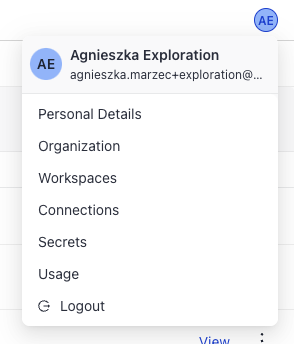Working in deepset AI Platform
In deepset AI Platform, you work within workspaces where you keep your data and pipelines. You can have multiple workspaces, each with different content. There are three interfaces (GUI, API, and SDK) you can use to interact with deepset AI Platform, depending on what's most convenient to you.
Workspaces
In deepset AI Platform, you work within organizations to which you were invited. Each organization may have multiple workspaces with different data. Each workspace keeps its content separate and doesn't share it with other workspaces.
Pipelines, indexes, files, and jobs are specific to a workspace. When you delete a workspace, all these data are deleted as well.
When you create a workspace, only you, as the creator and the Admin users in the organization, have access to it. To permit other users to access your workspaces, you must grant them access. For details, see Manage User Access.
After logging in, you land on the Home page, where you can view your workspace statistics, the number of searches run last week, and the details of the last five searches. These include the top answer (the answer with the highest relevance score) and the top file (the file containing the top answer). The search time is in seconds.
You can quickly switch between workspaces. Just click the workspace name and choose the one you want to switch to.
Navigation
Here's an explanation of what each navigation item does:
Navigation Step | Action |
|---|---|
Workspace name | Switch between workspaces |
Home | Access the guided workflow to create a pipeline. |
Files | Upload files. These are the files your pipeline uses for search. |
Indexes | Create indexes. |
Pipeline Templates | Choose a template. |
Pipelines | Create pipelines. |
Jobs | Schedule jobs to run asynchronously. Currently, you can run batch question answering across the filest in the workspace. |
Playground | Test your pipelines. |
Prompt Explorer | Engineer your prompts, try out different prompts, and compare them across up to three pipelines. |
Groundedness | Check how well your RAG system is grounded in your documents. |
Profile Settings
Clicking your initials in the top right corner opens a menu with additional settings. This table explains what each menu item does.

Menu Item | Action |
|---|---|
Personal Details | View your profile details, such as name, last name, and role. |
Organization | View the organizations you have access to. |
Workspaces | View workspaces in an organization. |
Connections | Connect deepset AI Platform to service and model providers. Once you establish a connection, you don't need to pass any API keys in your pipelines when using models or services from the connected providers. |
Secrets | Add and delete secrets to connect to providers and services not listed on the Connections page. To learn more, see Add Secrets to Connect to Third Party Providers. |
Usage | Check your usage of the platform. |
Three Interfaces
You can work in deepset AI Platform through one of these interfaces:
- An intuitive, user-friendly graphical user interface, where you can see real-life updates and get immediate feedback on your actions.
- REST API for a platform-independent way to communicate with deepset AI Platform. It supports all the tasks available in GUI.
- An open source SDK package you can customize. Currently, it contains methods for efficient file operations, such as upload or listing.
Updated about 2 months ago